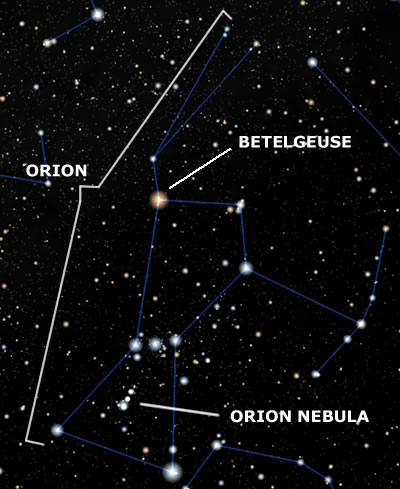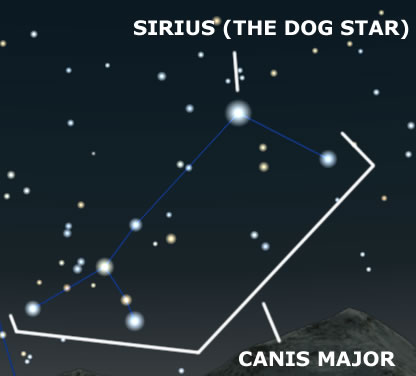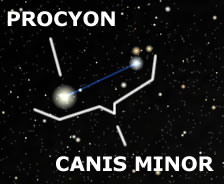Posts Tagged ‘sirius’
Stargazing
If you can get out this week, it is a great opportunity to do some Stargazing as the skies around the country are very clear at night time at the moment!
The Moon is quite small at the moment so the light from it isn’t quite bright enough to hide all the Stars. The brighter ones can still be seen very well especially Sirius (the Dog Star), Betelgeuse (the red coloured top left star in the constellation Orion) and Aldebaran (which is another red coloured star in the constellation Taurus). But the best object by far in the sky at the moment is the planet Jupiter. It is currently situated near to the Moon each night which makes it easy to spot. Jupiter’s Moons are also very clear at the moment and if you use a telescope, you can see at least four of them shining brightly around the huge planet (depending on where they are in their orbits). You can also just make them out using a decent pair of binoculars.
I had a great half an hour on Sunday night (before I nearly froze to death!) looking at the Moon and Jupiter. I could see the craters on the Moon very clearly as it was shining bright. I also had a great look at Jupiter and saw three Moons to start with, but then whilst I was watching, a fourth Moon peeped out from behind the giant planet. All four were shining brighter than I had probably seen them shine before. I could also see two of the purple coloured storm bands moving around the planet, just above and below the centre of Jupiter. It was an amazing sight and whenever I view Jupiter, I can never really believe what I am seeing! It’s that fantastic and awe-inspiring to me.
So take advantage of the clear skies and fine weather and do a bit of Stargazing tonight and let me know what you see by either leaving a comment on this post or tweeting me at @strethewey. Enjoy the viewing!
Orion Nebula, Sirius, Betelgeuse, Procyon and more
After several weeks of bad weather and tiredness due to busy work and a pregnant wife, I have been able to go out and view the Night Sky again.
A lot has changed since I last viewed the stars. Jupiter has now disappeared (from my viewing angle) and Orion has made its way along the night sky and is now settling in the South to South East area. The Plough has also come in to view and can be seen directly from my back garden towards the East.
The first thing I wanted to have a look at was the star Betelgeuse as Professor Brian Cox had said that it could turn into a Red Giant at any time. It would be amazing to see that happen in the sky and would be one of the highlights of my life. Unfortunately, the star was still looking the same through my binoculars and telescope, but I will keep checking it every clear night.
I also wanted to see if I could get a better view of the Orion Nebula which lies amidst the ‘Sword’ in the Orion Constellation. I had a look through my binoculars and telescope and could see a lot more than with the naked eye. What I could see was a blurry amount of light which is quite distinct compared with the rest of the space around it. It was exciting to be able to make this much out but I look forward to maybe getting a better look with a more powerful telescope when I can afford one. It was still a marvel to look at for me anyway.
Whilst I was looking at the Orion Nebula through the telescope, either a Satellite or a Meteor shot across the viewer. I’m not 100% sure what it was but it didn’t have any lights which can sometimes be seen on a satellite so I am leaning towards it being a meteor. It was so far away in the sky that it wouldn’t have been viewable by the naked eye. Perhaps someone can tell me what it was? I spotted it at about 8pm last night (24th March 2011).
There was one star in the sky that my wife and I always wondered what it was as it looked like a Helicopter or an Aeroplane suspended in the sky, with its lights flashing red and blue. After taking a closer look using our equipment and consulting the Internet, we found it to be Sirius (also known as the Dog Star and part of the constellation ‘Canis Major’). It is the brightest star in the sky and the red and blue twinkling that it gives off is due to its light hitting the atmosphere of the Earth and refracting in the gases. We are both glad that we now know what it is!
The final area of the Sky that I had wanted to take a look at was the bright star to the left of Orion. This star is called ‘Procyon’ and forms part of the constellation ‘Canis Minor’. This is also a very bright star, although obviously not as bright as Sirius. I couldn’t see much more detail through the telescope which was a shame, but at least I now know its name.


